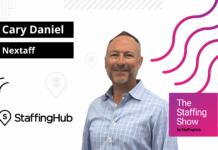
Key takeaways:
- The “entry-level” job is broken: The traditional career path for new graduates is failing. AI and automation are eliminating the simple tasks they once used to gain experience, creating a “graduate gridlock” where a majority are underemployed.
- The 65+ workforce is an untapped asset: The fastest-growing demographic in the workforce is also loyal, high-performing, and (contrary to stereotypes) willing to learn new technology and AI, making them a reliable solution to talent shortages.
- The mandate has changed from finding to building: The new competitive advantage lies in building talent to solve the entry-level experience gap (e.g., train-to-hire) and integrating the high-value 65+ workforce.
While executives consistently rank finding high-quality, reliable talent as a primary frustration, there’s a new generation of educated workers struggling to find its footing and an experienced, older generation of talent growing faster than any other demographic.
Unemployment rises among new workers
At the entry-level, the market is experiencing a structural breakdown. A recent report from MyPerfectResume highlights the hiring crisis brewing for fresh graduates. Unemployment rates for recent degree holders (ages 22-27) surged to a recent high, and the employment gap between those with a degree and those with only a high school diploma is the narrowest it has been in 30 years.
This is more likely to be a shift in workforce trends rather than a temporary downturn. The report notes that many employers are giving their “entry-level” roles to candidates with three or more years of experience. The result is that more than half (52%) of the Class of 2023 found themselves underemployed one year after graduation, working in jobs where their degrees are unnecessary.
For staffing leaders focused on digital transformation, the cause probably sounds familiar. AI and automation are eliminating the traditional learning curve. Foundational tasks in tech, finance, and analysis, the very work that used to build a recent graduate’s experience, are now being automated. This creates a bottleneck, locking out new talent before they can even begin.
The “Silver Tsunami” becomes a strategic asset
Meanwhile, the 65-and-over workforce is redefining the other end of the talent spectrum. According to new research from SHRM, this demographic is the fastest-growing segment of the U.S. workforce.
And this talent pool is not just staying for financial reasons (59%). They’re driven by a desire to stay mentally active (70%) and to maintain a sense of purpose (50%).
These seasoned workers could be an untapped opportunity for staffing leaders focused on delivering quality. HR professionals report that 92% of these older workers perform as well as or better than other employees. And they bring attributes in high demand: exceptional loyalty (83%), specialized knowledge (82%), and high engagement (60%).
For leaders pushing tech adoption, the SHRM report shatters a common myth. This workforce is ready to adapt. An overwhelming 74% are willing to participate in AI upskilling, and 81% are confident in their ability to learn new workplace technologies.
Action items for staffing agencies
- Solve the entry-level bottleneck: Clients need talent but are hesitant to invest in training and unproven talent. Staffing firms can bridge this gap. This is a strategic opportunity to move beyond simple placement and create value through “train-to-hire” programs, apprenticeships, and structured “first-step” experiences that build the one to three years of experience the market expects.
- Champion the seasoned workforce: Agencies can become advocates for the 65+ talent pool. Use the data to combat age-related stigma and frame these candidates as a high-ROI solution for stability, knowledge transfer, and tech adaptability. They are a reliable, skilled, and engaged resource ready to be deployed.
The fundamental nature of talent sourcing is changing. The market no longer just needs agencies to find talent; it needs them to build it at the entry point and re-integrate it at the experienced end.





